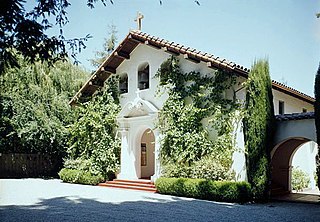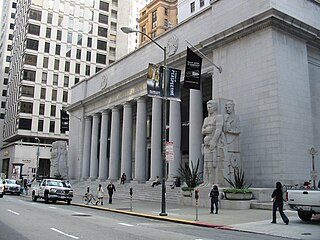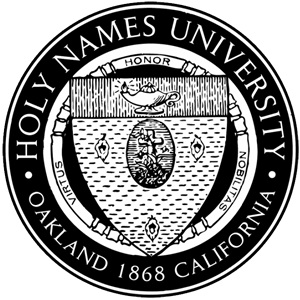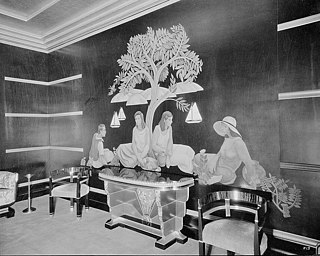
Portola Valley is a town in San Mateo County, California, United States. Located on the San Francisco Peninsula in the Bay Area, Portola Valley is a small, wealthy, mostly white community nestled on the eastern slopes of the Santa Cruz Mountains.

Woodside is a small incorporated town in San Mateo County, California, United States, on the San Francisco Peninsula. It has a council–manager system of government.

The Pacific Exchange was a regional stock exchange in California, from 1956 to 2006. Its main exchange floor and building were in San Francisco, California, with a branch building in Los Angeles, California.

Julia Morgan was an American architect and engineer. She designed more than 700 buildings in California during a long and prolific career. She is best known for her work on Hearst Castle in San Simeon, California.

The Bohemian Club is a private club with two locations: a city clubhouse in the Nob Hill district of San Francisco, California, and the Bohemian Grove, a retreat north of the city in Sonoma County. Founded in 1872 from a regular meeting of journalists, artists, and musicians, it soon began to accept businessmen and entrepreneurs as permanent members, as well as offering temporary membership to university presidents and military commanders who were serving in the San Francisco Bay Area. Today, the club has a membership of many local and global leaders, ranging from artists and musicians to businessmen. Membership is restricted to men only.

Arthur Brown Jr. (1874–1957) was an American architect, based in San Francisco and designer of many of its landmarks. He is known for his work with John Bakewell Jr. as Bakewell and Brown, along with later works after the partnership dissolved in 1927.

Bernard Ralph Maybeck was an American architect in the Arts and Crafts Movement of the early 20th century. He was an instructor at University of California, Berkeley. Most of his major buildings were in the San Francisco Bay Area.

Ladera is a census-designated place (CDP) in southern San Mateo County, California, adjacent to Portola Valley. Primarily a residential community, it comprises approximately 520 homes, governed by the Ladera Community Association. The ZIP Code is 94028 and the community is inside area code 650. The population was 1,557 at the 2020 census.

Willis Jefferson Polk was an American architect, best known for his work in San Francisco, California. For ten years, he was the West Coast representative of D.H. Burnham & Company. In 1915, Polk oversaw the architectural committee for the Panama–Pacific International Exposition (PPIE).

Holy Names University was a private Roman Catholic university in Oakland, California. It was founded in 1868 by the Sisters of the Holy Names of Jesus and Mary with which the university remained affiliated until it closed in 2023.

The Pacific-Union Club is a social club located at 1000 California Street in San Francisco, California, at the top of Nob Hill. It is considered to be the most elite club of the West Coast, and one of the most elite clubs in the United States, along with the Knickerbocker Club in New York, the Metropolitan Club in Washington D.C., and the Somerset Club in Boston.

Timothy Ludwig Pflueger was an architect, interior designer and architectural lighting designer in the San Francisco Bay Area in the first half of the 20th century. Together with James R. Miller, Pflueger designed some of the leading skyscrapers and movie theaters in San Francisco in the 1920s, and his works featured art by challenging new artists such as Ralph Stackpole and Diego Rivera. Rather than breaking new ground with his designs, Pflueger captured the spirit of the times and refined it, adding a distinct personal flair. His work influenced later architects such as Pietro Belluschi.

Sacred Heart Schools, Atherton is a private, Roman Catholic, co-educational school in Atherton, California, United States. It was established in 1898 by the Society of the Sacred Heart and is governed by an independent board of trustees.
James Rupert Miller was an architect active in San Francisco, California in the first half of the 20th century. Miller gained prominence after the 1906 San Francisco earthquake when his firm was one among many called upon to rebuild the stricken city.

Our Lady of the Wayside Church is a modest church built in 1912 for the then-growing Catholic parish of Portola Valley by a combined effort of Jewish, Protestant and Catholic members of The Family, a San Francisco men's club that owns a nearby rural retreat.

Ralph Ward Stackpole was an American sculptor, painter, muralist, etcher and art educator, San Francisco's leading artist during the 1920s and 1930s. Stackpole was involved in the art and causes of social realism, especially during the Great Depression, when he was part of the Public Works of Art Project, Federal Art Project of the Works Progress Administration, and the Treasury Department's Section of Painting and Sculpture. Stackpole was responsible for recommending that architect Timothy L. Pflueger bring Mexican muralist Diego Rivera to San Francisco to work on the San Francisco Stock Exchange and its attached office tower in 1930–31. His son Peter Stackpole became a well-known photojournalist.
Miller and Pflueger was an architectural firm that formed when James Rupert Miller named Timothy L. Pflueger partner. Pflueger, at the time a rising star of San Francisco's architect community, had begun his architectural career with architecture firm, Miller and Colmesnil sometime in 1907, under the tutelage of James Rupert Miller. Together, Miller and Pflueger designed a number of significant buildings in San Francisco, including the Pacific Telephone & Telegraph Company Building which was the city's tallest skyscraper for four decades.
Clarence William Whitehead Mayhew was an American architect best known as a designer of residential structures in the San Francisco Bay Area. Recognition came to him with a home designed in 1937 for the Manor family in Orinda, California; one which was included as an example of modern architecture's effect on the contemporary ranch house in California in several post-war published compilations of residential works.

Charles Stafford Duncan (1892–1952) was a San Francisco painter and lithographer perhaps best known for his mural in the Paramount Theatre in Oakland, California. He won the Benjamin Altman Prize from the National Academy of Design in 1937.















